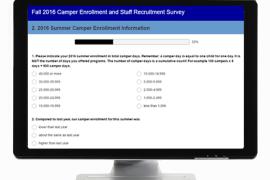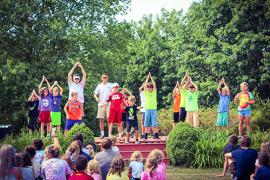Greetings camp friends, and a big shout out to the many, many camp folks we have shared research with at recent ACA events, including the ACA National Conference and the Tri-State Camp Conference. But the road show is just getting started. Next week we will be at the New England Camp Conference, then the Mid States Camp Conference, and finally (for now at least), the Spring Leadership Conference in Southern California.
The enthusiasm toward camp research, and ACA’s Impact Study specifically, so far has been incredible. Camp professionals ranging from new, frontline staff to seasoned directors share that what we are finding — that the impacts of camp last far beyond camp — will help them advocate for camp to parents, administrators, and potential funders. In addition to our findings related to the long-term impacts of camp, we are also starting to explore what happens at camp to promote lasting learning, which will give camp professionals practical tools to implement high-quality (and impactful!) programs.
Speaking of practical, I want to share with you a big theme from our time-sharing research at two recent camp conferences, and that theme is practical. We hear from camp folks that camp research is great, but what they really need are practical, research-based tools they can use to design programs, train staff, and market to parents and other stakeholders. This is music to my ears.
Why? Because we believe that camp research is only as good as its use in camp.
Let me give you a couple of examples.
In 2004, ACA released the results from a first-ever national study on the outcomes of camp. This study included pre- and post-camp assessments from nearly 5,000 campers, with additional input from camp staff and parents, and concluded that outcomes such as independence, friendship skills, peer relationships, adventure and exploration, and values and decisions were among the key outcomes of camp. The practical part? These outcomes were translated into survey tools camp professionals can use to measure camper outcomes and share what they learn to improve programs and market their camp. Together, these tools are called the Youth Outcomes Battery and are used to measure camper outcomes at camps of all shapes and sizes.
More recently, ACA partnered with the Weikert Center for Youth Program Quality to explore what program quality looks like at camp. Based on their widely adopted and research-based Youth Program Quality Assessment Tool, Weikert Center, in partnership with ACA, examined what the tool measured and how it was used specifically at camps (day and overnight). The research team made several adaptations and additions based on their findings, most notably in the addition of a “nature supplement” that helps practitioners explore program quality in nature-based settings. The results of this study were used to build an assessment tool that can be used as an observation form or a staff training checklist.
But What about the Impact Study?
That brings us to the Impact Study, ACA’s five-year study focusing on the lasting impacts of camp experiences among campers and staff. To best understand how important it is that the Impact Study findings are practical and accessible for camp professionals, I thought I’d share some pieces of the original Request for Proposals (RFP), the document and all-volunteer task force created to seek proposals from research institutions (because, you know, we are way too excited about camp to do our own research!).
First, a snapshot of the original research question:

You should see in this question much of what we have described in previous Research 360 blog posts (about lessons learned so far from the impact study, the camp staff experiences expansion of the study, findings from Phase 1 and Phase 2 of the study, and what's happening during Phase 3, among others), but what I want you to notice is the notion of “if so, what enables the development . . . “ This is the how piece — we don’t want to know just what people get out of a camp experience, but how that happens so we can intentionally design programs for lasting learning.
You can see this reflected in a list of expectations stated in the RFP:

Stating this in the RFP ensured that the research project prioritized practicality; that, from the beginning, the study had to address research questions of practical importance and the final products had to be practical to use at camp.
Why am I writing about this now? Because I want every camp professional to know that you and your camp program are the priority.
And you are busy. As a former day camp director, I know first-hand the priorities of a running camp (Enrollment! Safety!). Research needs to be practical in its design, but it also needs to be practical to read and to use. That’s why we write about the Impact Study in bite-sized pieces in this blog, and present in-person to camp professionals every chance we get. We have an infographic and more on the way, and will soon have full reports (with easy-to-read summaries) that you can download and share with your audiences. Perhaps most exciting right now is a series of short videos and one longer video (“The Story”), all available on our Impact Study web page, designed for you to share with your networks however you see fit.
So, as I head into three more back-to-back ACA conferences, I look forward to hearing from folks how they use research, and how we can make our research accessible and practical.
In the meantime, watch and share our Impact Study videos!
Laurie Browne, PhD, is the director of research at ACA. She specializes in ACA's Youth Outcomes Battery and supporting camps in their research and evaluation efforts. Prior to joining ACA, Laurie was an assistant professor in the Department of Recreation, Hospitality, and Parks Management at California State University-Chico. Laurie received her Ph.D. from the University of Utah, where she studied youth development and research methods.
Photo courtesy of Camp Howe in Goshen, Massachusetts
Thanks to our research partner, Redwoods.
Additional thanks goes to our research supporter, Chaco.
The views and opinions expressed by contributors are their own and do not necessarily reflect the views of the American Camp Association or ACA employees.





